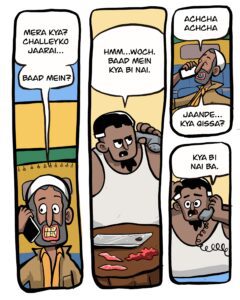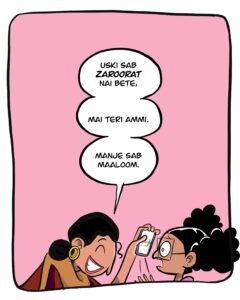
HalluBol aims to expand the platform and invite Dakhni-speaking voiceover artists, writers, poets, illustrators, rappers, painters, and creators. (Supplied)
Dakhni (or Dakni or Deccani) is often mistakenly considered a dialect of Urdu. But it is an amalgamation of Persian, Marathi, Kannada and Telugu languages.
Different regions in Deccan India exhibit slight tonal variations in Dakhni. “Their colloquial vocabulary incorporates words influenced by various local languages,” explains Rahil Mohsin, a Bengaluru-based Dakhni speaker.
“For instance, Dakhni spoken in Karnataka might include words from Kannada such as “waaram” (meaning week), derived from the Kannada word “waara”. Similarly, Dakhni spoken in Hyderabad might share similar words, but their tonal delivery differs significantly when attentively listened to.”

Rahil Mohsin and Alankrita Amaya aim to curate anthologies that bring forth more stories from ordinary individuals into the hands of readers. (Supplied)
Growing up, little did Mohsin and his family know that the language they were speaking at home was ‘Dakhni’.
“Often referred to as chhapri Urdu, tapori Urdu, or phatte Urdu by non-Dakhni speakers, We always believed it to be a dialect of Urdu; ” says the 33-year-old.
According to Mohsin, it is through humour that Dakhni has been predominantly represented in mainstream media. But, Dakhni speakers are not amused with the stereotyping.
“The Dakhni language is stereotyped in “The Angrez” film series (2005, 2015). Its people and their culture are regrettably portrayed as dim-witted buffoons,” Mohsin rues.
“As a result, these representations have shaped the perceptions of non-Dakhni speakers.”
In a quest to break these stereotypes and create more meaningful content, Mohsin and his partner Alankrita Amaya have started the HalluBol initiative on Instagram.
Thirty-two-year-old Amaya is a children’s book writer and illustrator. Raised in Chennai, Amaya grew up in a Hindi-speaking household.
“As a Hindi speaker, I didn’t realise the privilege I carried with it, till I started learning Dakhni (while conversing with Mohsin),” says Amaya.
“I was surprised to witness the unfair judgement faced by the language.”

As a Hindi speaker, Amaya didn’t realise the privilege she carried with it, till she started learning Dakhni. (Supplied)
She realised there was a scarcity of creative and artistic content in the language itself.
This planted a seed to start HalluBol early this year.
“We started HalluBol to address the influx of problematic Dakhni content on social media,” says Mohsin.
“Many reels or forwards posted in WhatsApp groups contained content promoting homophobia, toxic masculinity, sexism, and more. Everyone, including children, consumed this content,” he elaborates.
HalluBol is a gateway to thought-provoking content in the form of motion comics.
The concept for HalluBol is simple.
“We showcase aspects of everyday life through the eyes of Dakhni speakers to the world, eradicating any shame or stigma associated with the language,” Amaya says.
Their vision for HalluBol is to expand the platform and invite Dakhni-speaking voiceover artists, writers, poets, illustrators, rappers, painters, and creators to collaborate with them.
“We aim to curate anthologies that bring forth more stories from ordinary individuals into the hands of readers. Additionally, we aspire to create fully animated adaptations that represent Dakhni stories and ideas,” Amaya informs.
Mohsin says there is a huge resurgence of Dakhni, with some performing artists taking pride in the language before the world.
“Several Dakhni-speaking performance artists, like Pasha Bhai, are bridging intercultural gaps through cyphers held across the city, and now on a nationwide scale,” he says.
“It brings me great hope to see that efforts are being made to create awareness about a language that has been misunderstood and often labelled as “inferior”,” he adds.
Mohsin has a degree in 3D animation. His career began in 2012 as a storyboard artist. A year later, he got his first commission as a comic book artist with Sufi Comics — a Bengaluru-based comic book publisher that makes Islamic comics.
He has also collaborated with international authors on various anthologies. Mohsin has also self-published four comic book titles.
Similarly, Amaya has completed an animation course, and published a book titled, Miaow, in 2011.
With both their creative skills aligned, it was easy to collaborate on the HalluBol project.
Growing up, Mohsin mainly encountered content in either Hindi or English.
While there is nothing inherently wrong with that, there was a lack of Dakhni representation in the media, he says.
“This lack of representation can lead to the isolation of a particular group, resulting in issues like low self-esteem. It becomes crucial for a cultural movement to emerge when a language’s identity is stripped, distorted, and generalised by mainstream perception,” he details.
Mohsin is grateful to yesteryear singer Mohammad Rafi for immortalising a popular Bollywood song, Hum kaale hai toh kya hua dil waale hai, which had Dakhni representation.
This year, Mohsin will be exhibiting his works at the Comic Con event. He also plans to publish a Dakhni book, which is based on toxic masculinity.
“Glorification of toxic traits like suppressing emotions, or aggression is unfortunately a part of Dakhni culture, as is in many other cultures,” Mohsin rues.
Through their comic book, Mard Bann (Be a Man), the duo aims to address this issue through a short slice-of-life story.
“The characters in our online short strips will play larger roles in the book. This will allow for deeper exploration of their characters. Mard Bann will incorporate a blend of humor and poignant moments,” he signs off.

May 01, 2024

Apr 30, 2024

Apr 30, 2024

Apr 30, 2024

Apr 30, 2024

Apr 30, 2024